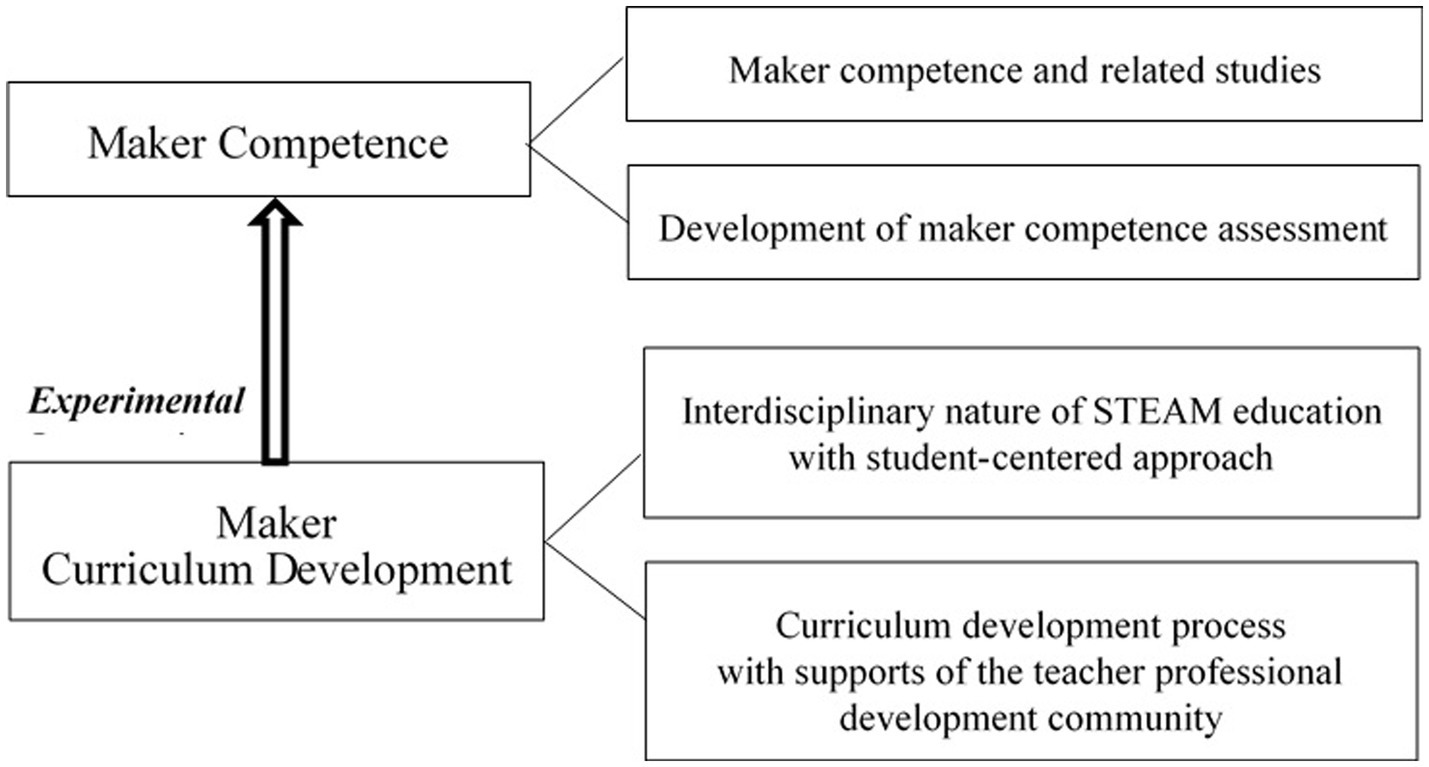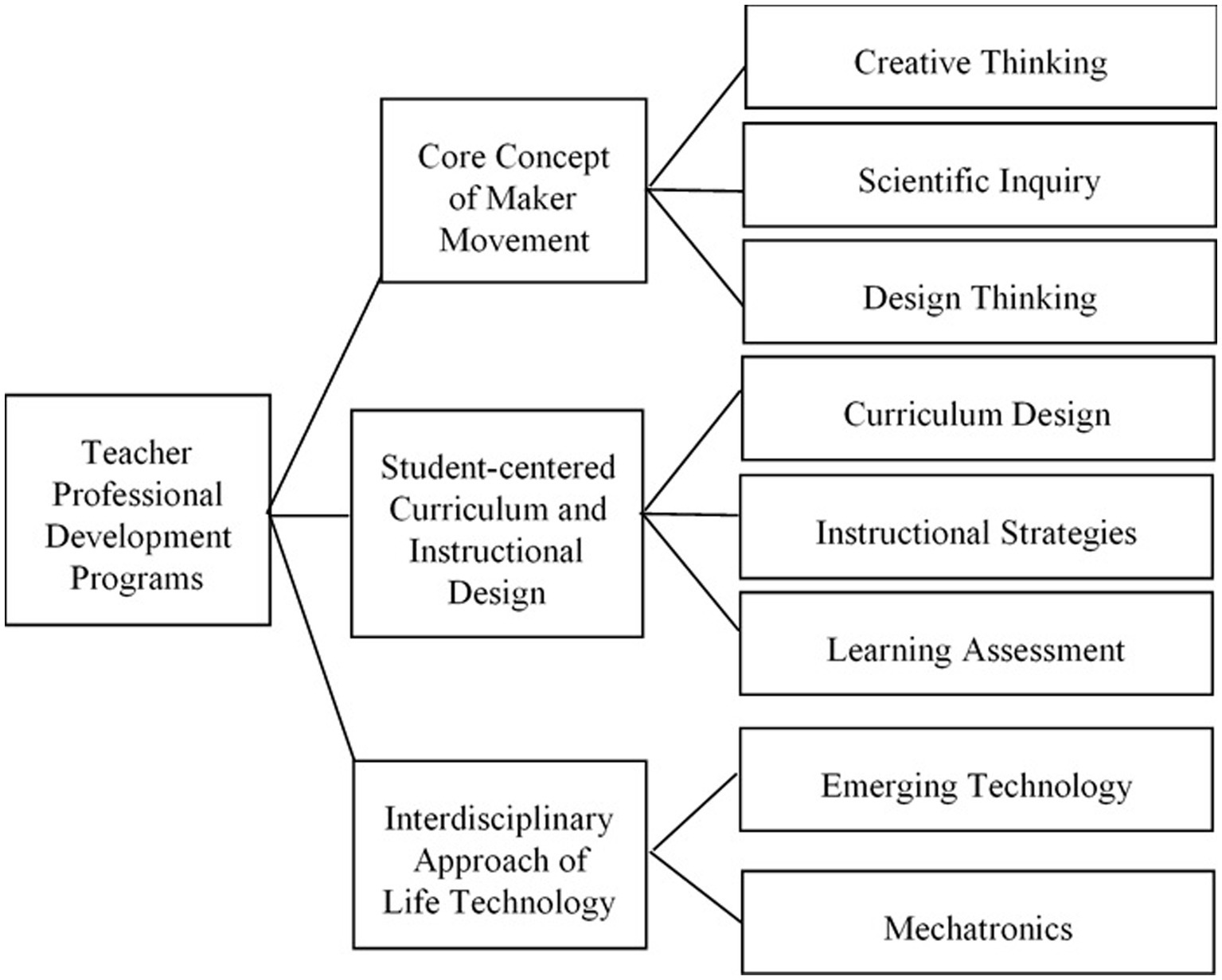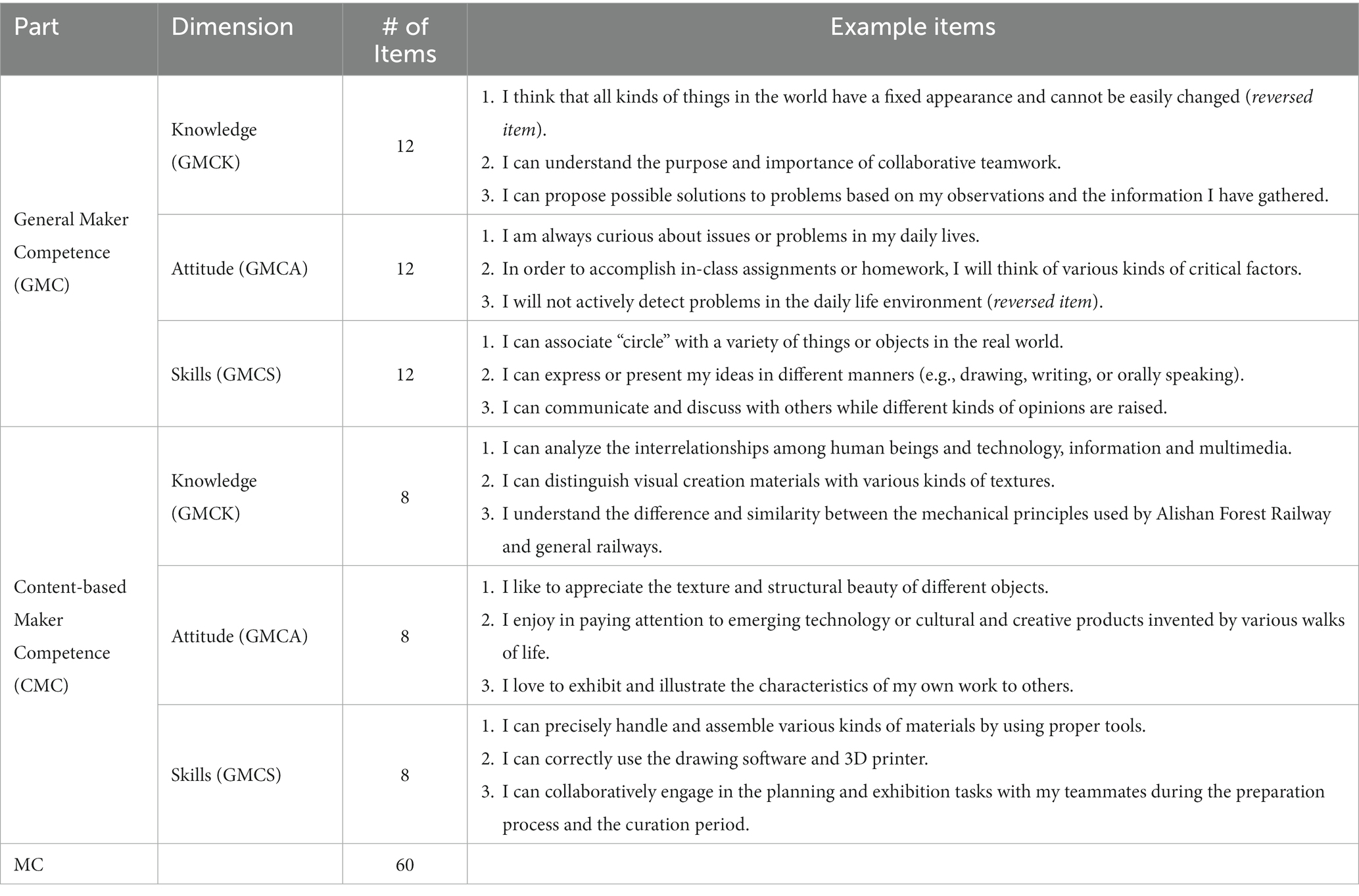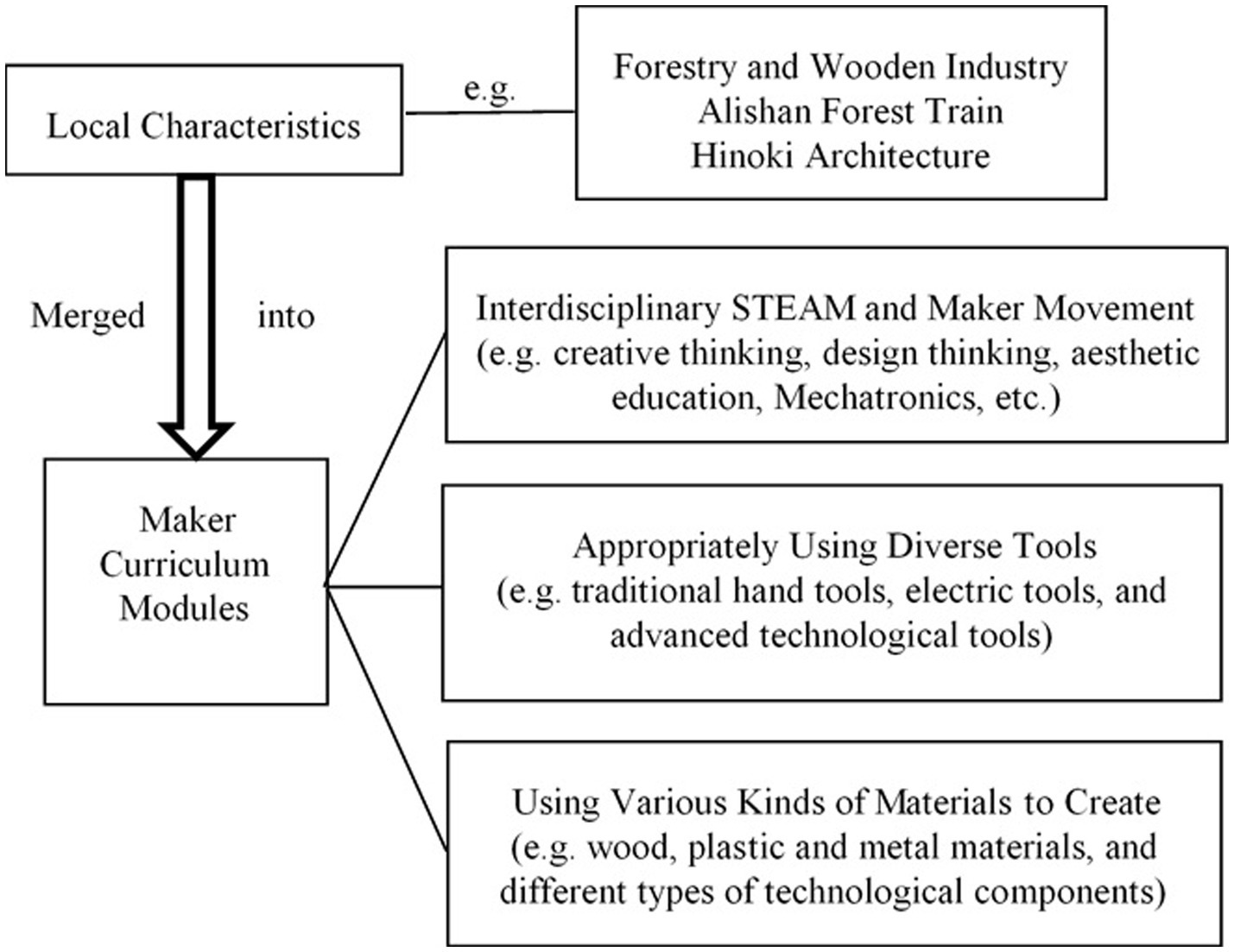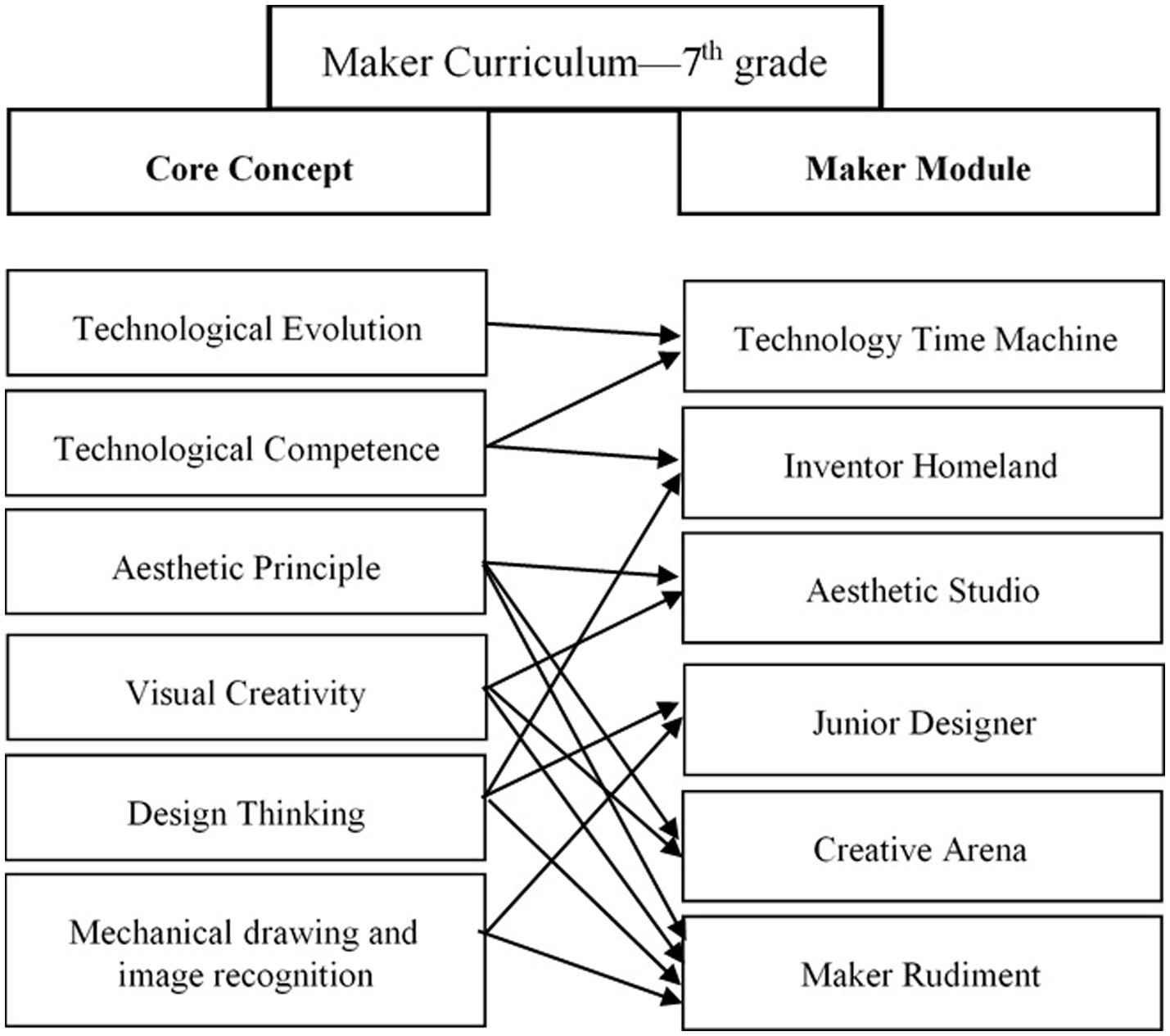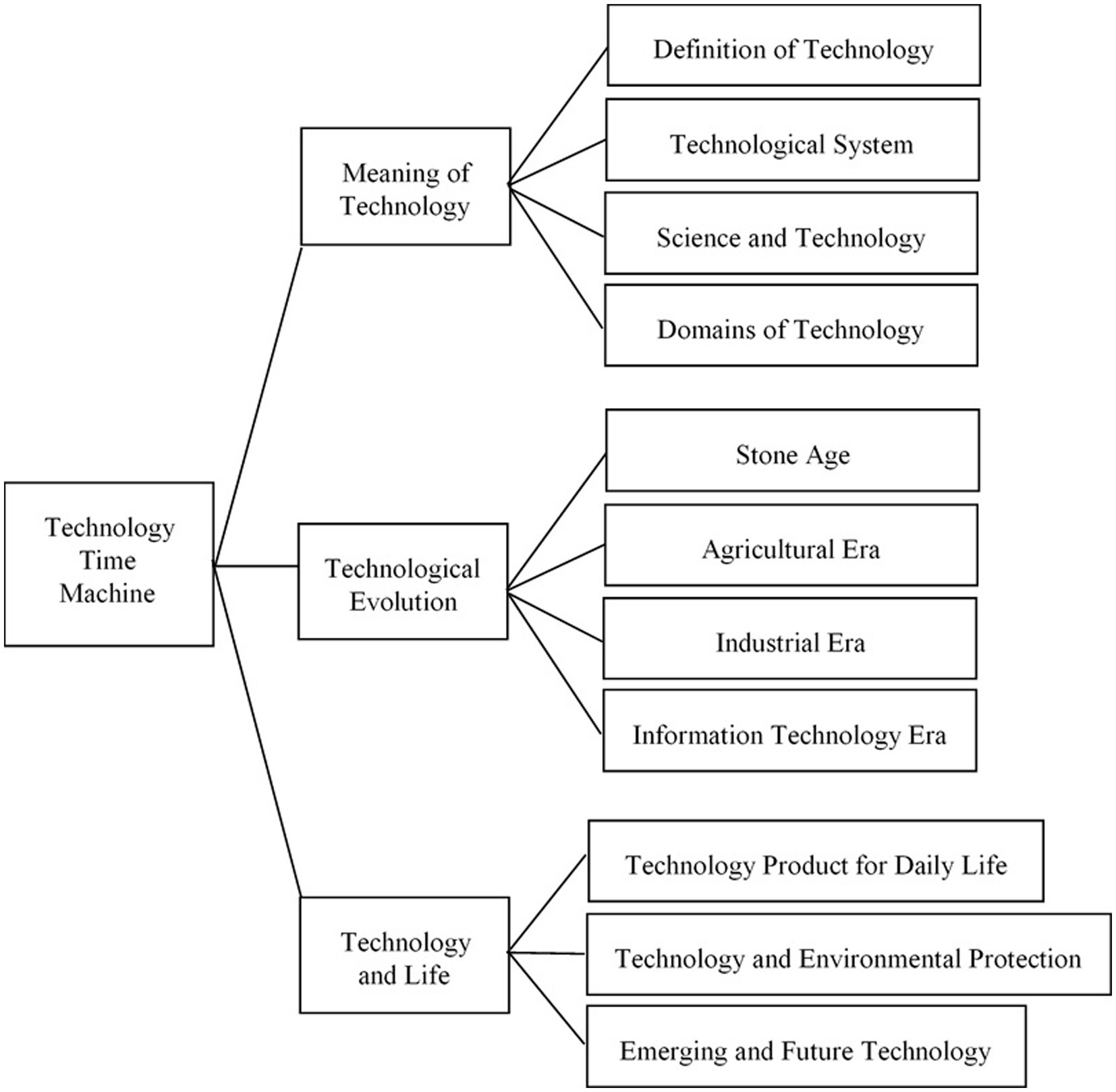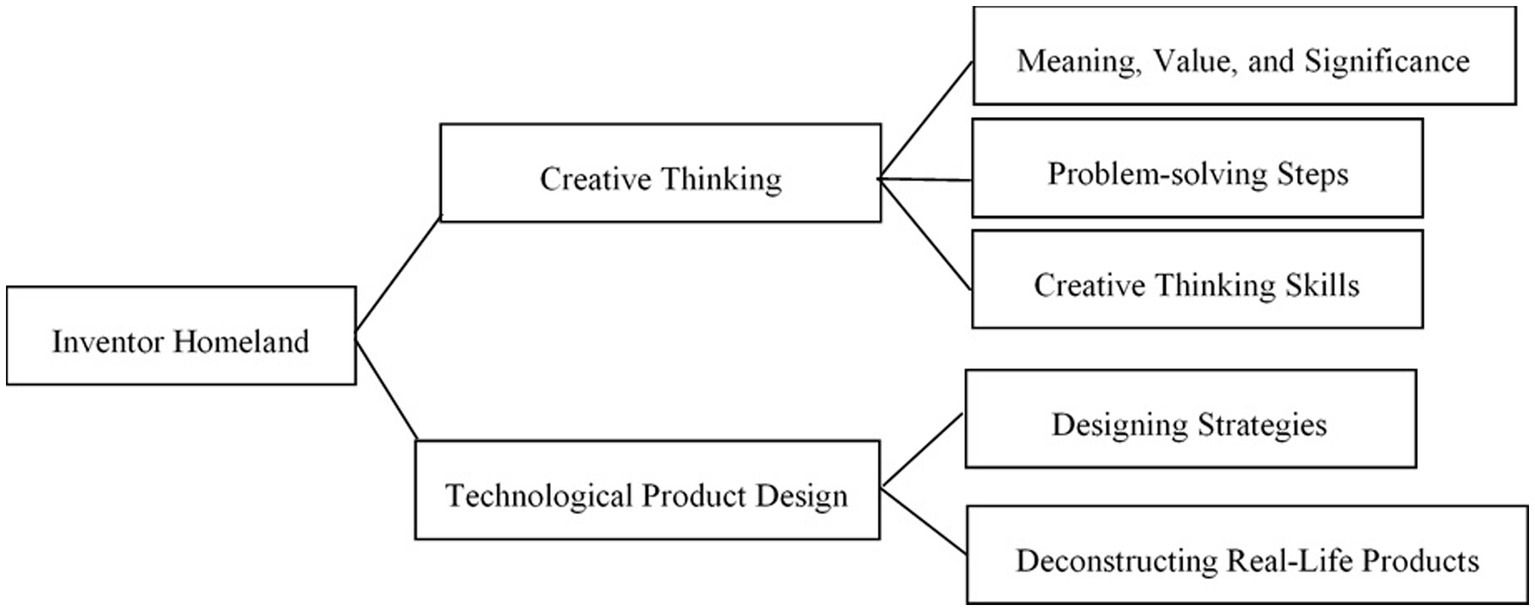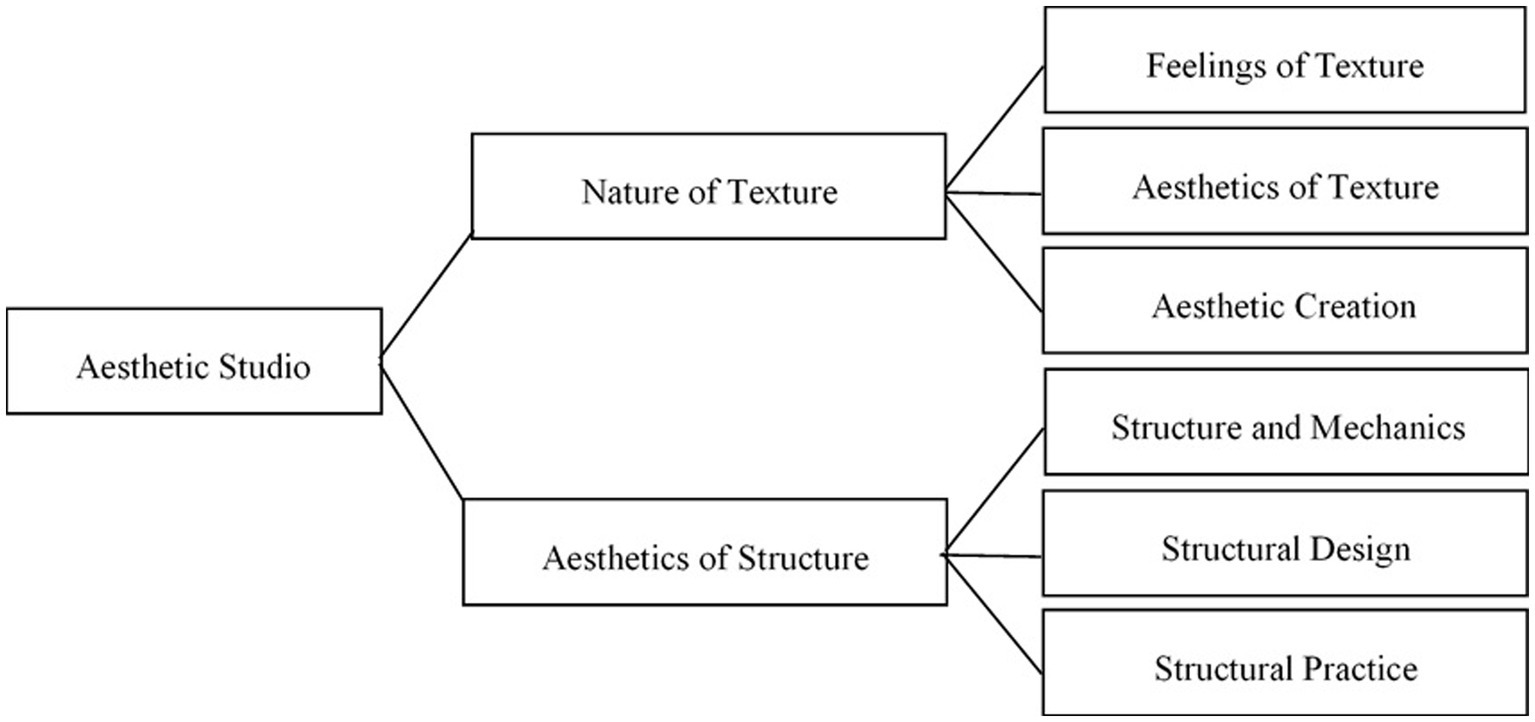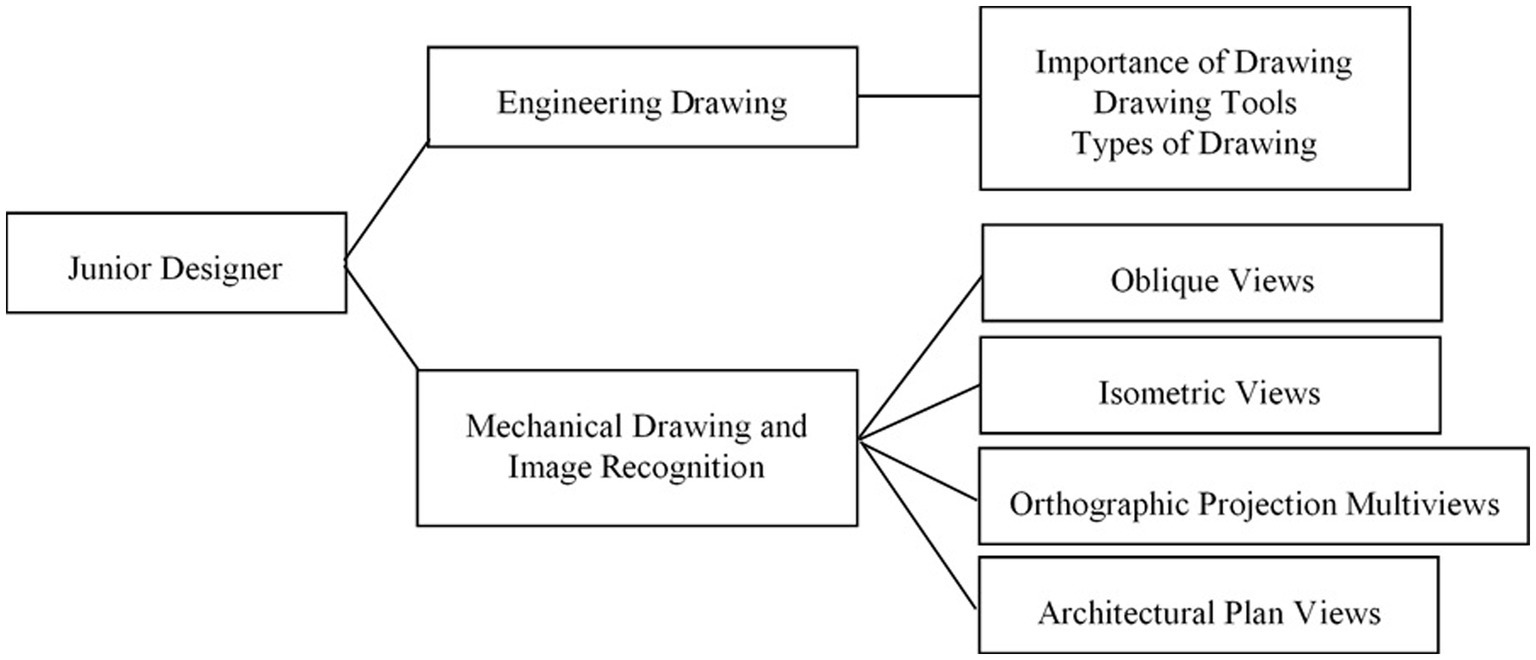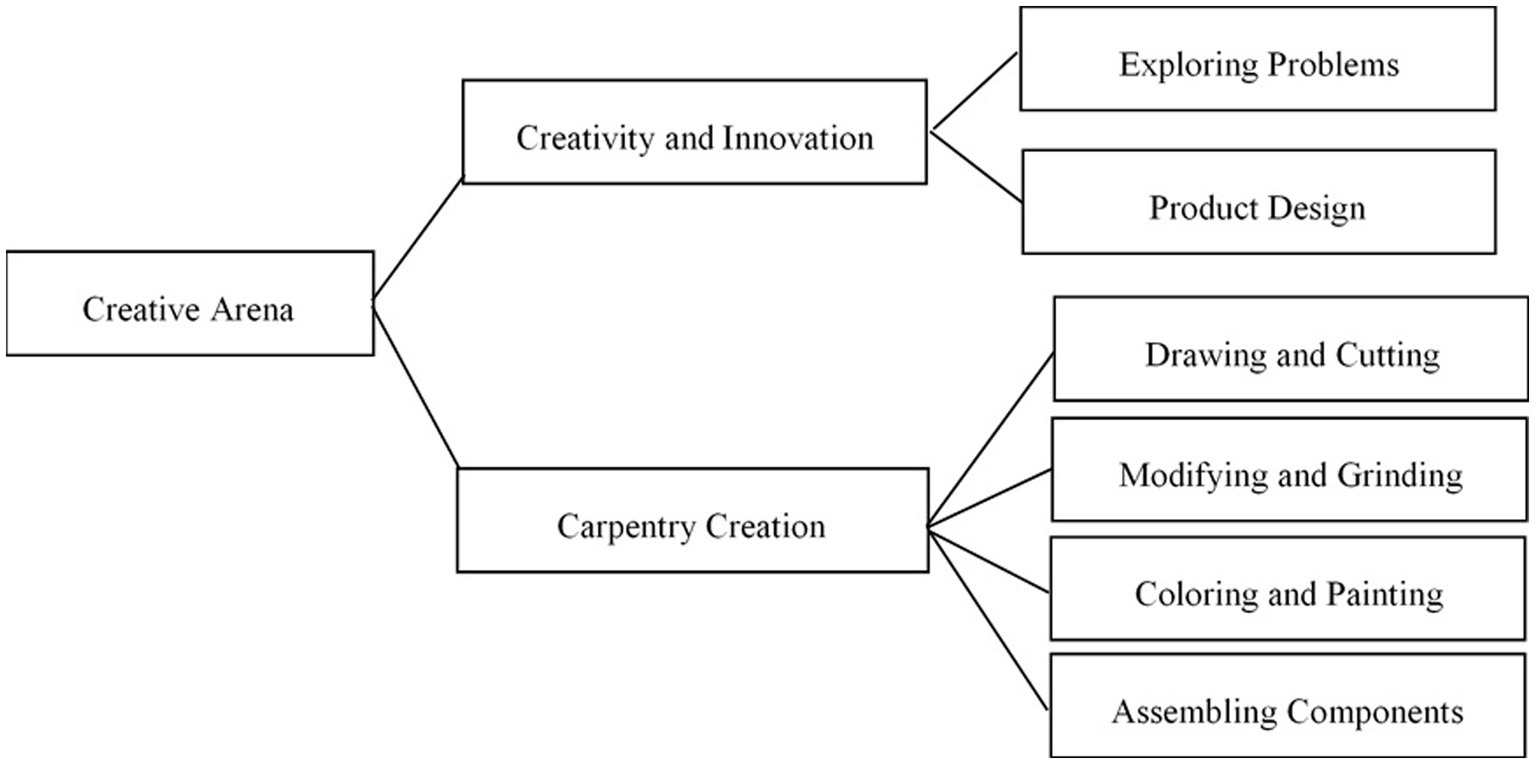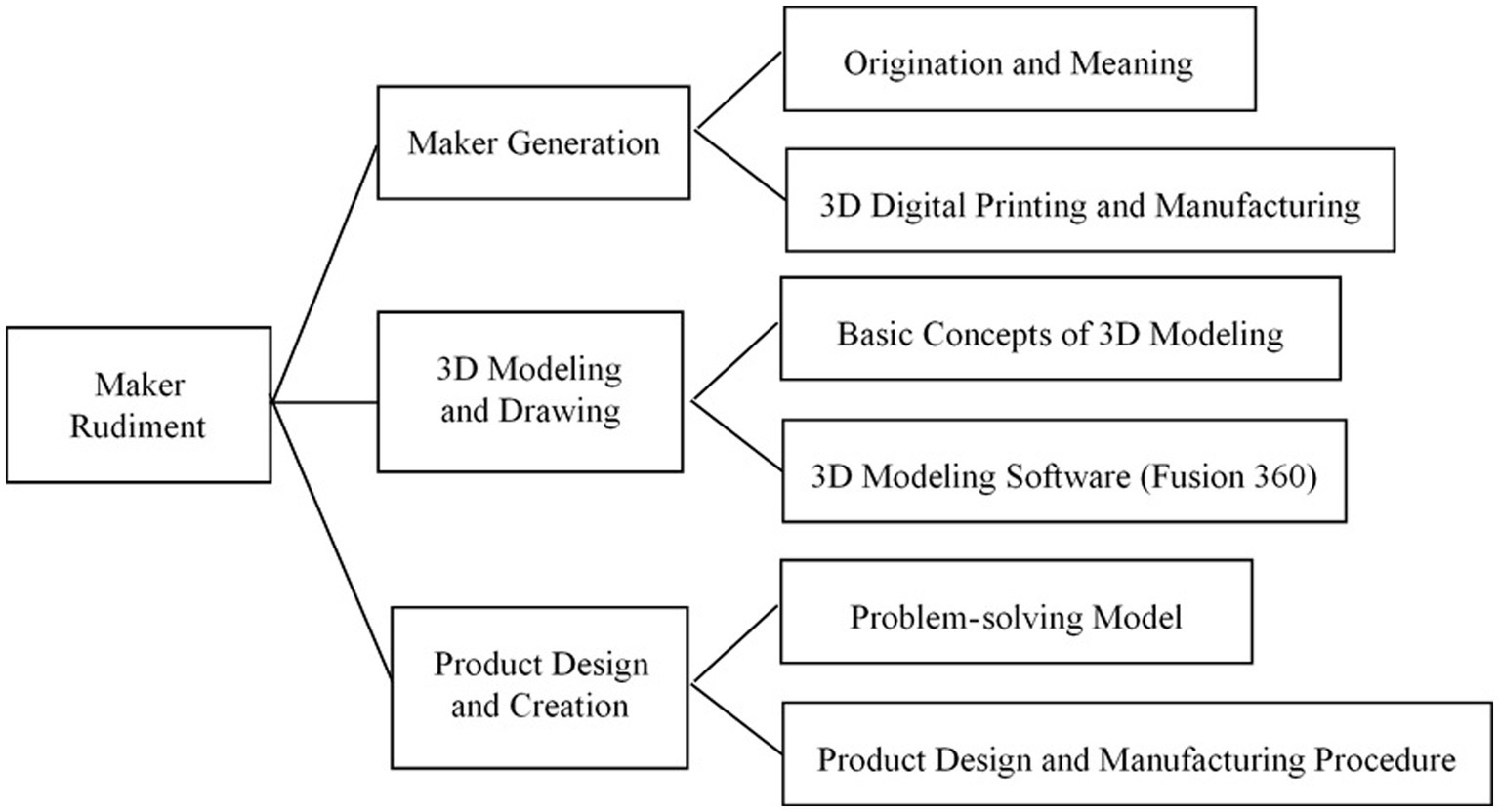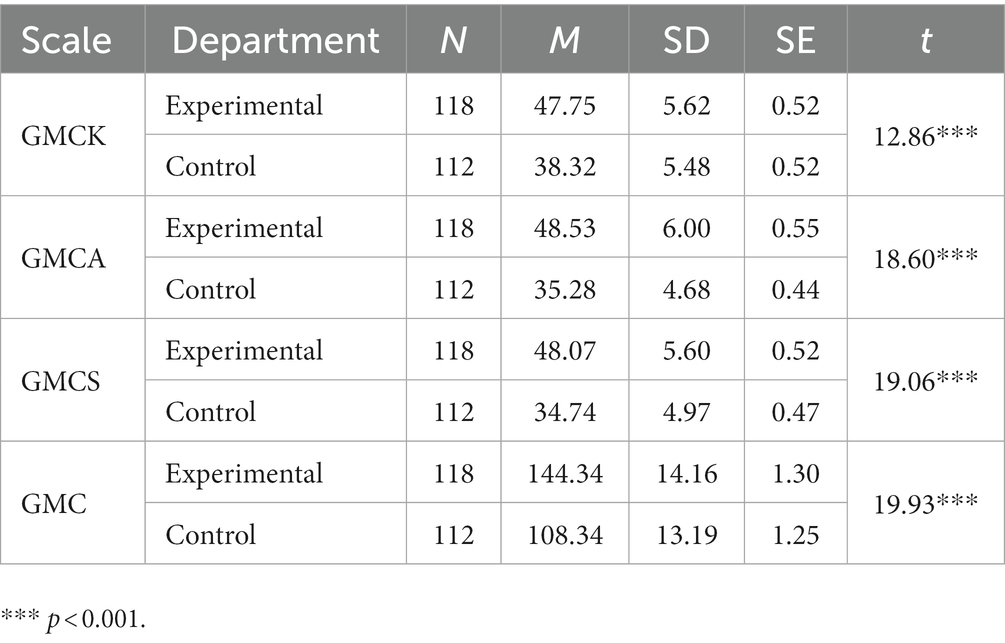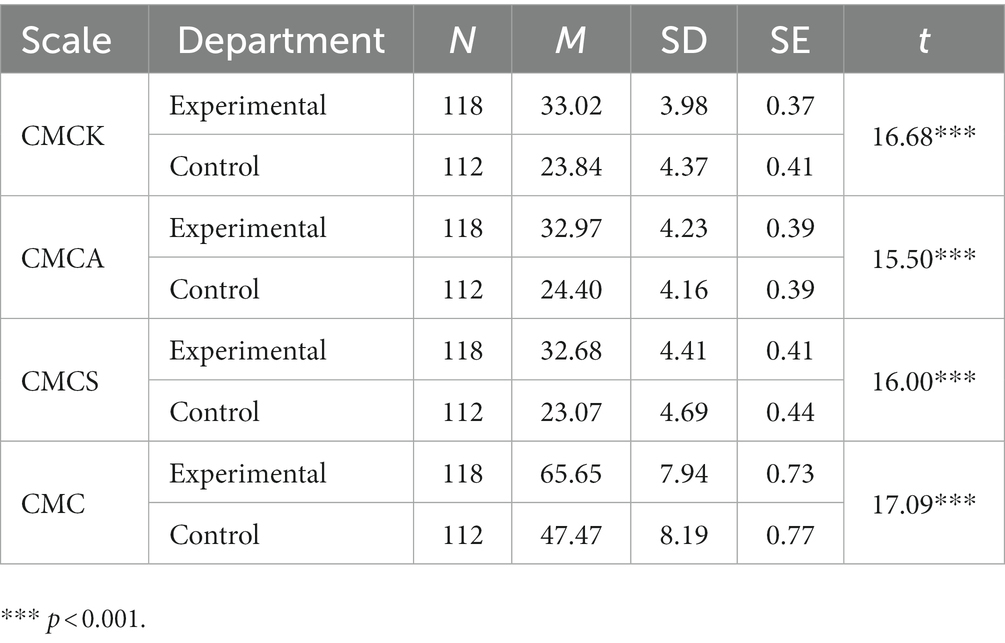- 1Department of Early Childhood Education, National Chiayi University, Chiayi, Taiwan
- 2Department of Education, National Chiayi University, Chiayi, Taiwan
“Competence” is a very important concept in education and has been valued by several countries and international organizations in recent years, sparking a wave of curriculum reforms worldwide. The STEAM education is considered a feasible way to equip all students with problem-solving skills in various real-world situations and complicated challenges, as well as nurturing them 21st century skills and competencies. Moreover, a recent maker movement that focuses more on hands-on creation, design, and innovation is considered an innovative way to redefine the learning process through which students’ maker competence can be nurtured. Based on this trend, new national curriculum guidelines were established by Taiwan’s Ministry of Education in 2014. Particularly for the technology domain in the junior high school level (grade 7–9), “Life Technology” and “Information Technology” become requirements, where an interdisciplinary and competence-based maker curriculum needs to be developed. Based on this curriculum reform wave, we emphasize for the implementation of a targeted maker curriculum as a way to increase 7th-grade students’ maker competence. A post-test quasi-experimental design was employed to gather the data, and corresponding statistics were applied for quantitative comparison. A total of 230 7th-graders from eight classes in the targeted junior high schools participated in this study. Students in the experimental group received an interdisciplinary and competence-based maker curriculum as the intervention, which was designed and implemented with the support of the teacher professional development community and briefly presented in this paper. The quantitative findings revealed that the 7th-graders who received the experimental intervention possessed significantly superior marker competence compared to those who received regular technology courses. Based on these findings, maker competence (i.e., knowledge, attitude, and skills), which can be fully established within interdisciplinary and competence-based maker classrooms, was significantly favorable for helping targeted adolescents survive in this ever-changing and fast-paced era. Consequently, as teacher educators and teachers, we must endeavor to redefine the way of learning and construct a learning environment that is full of the maker spirit and STEAM integration.
1. Introduction
1.1. Cultivating students’ competence based on the curriculum reform trend
Competence is defined as “a physical or intellectual ability,” “a performance capacity,” or even “an underlying complex ability” (Shavelson, 2010, p. 44). It is also regarded as “a disposition that enables a person to perform successfully in content-related, complex, and demanding problem situations” (Kulgemeyer and Schecker, 2014, p. 258). The United Nations Educational, Scientific, and Cultural Organization (UNESCO), European Union (EU), Organization for Economic Co-operation and Development (OECD), and other international organizations have emphasized the importance of “competence” (Rychen and Salganik, 2003). The OECD study, named “Definition and Selection of Competencies: Theoretical and Conceptual Foundations,” has sparked a wave of curriculum reform in various countries (Malewski, 2010; Organization for Economic Co-operation and Development, 2010) that aims to help students achieve a successful personal life and build a sound functioning society (Canto-Sperber and Dupuy, 2001).
Historically, the curricula and instruction of certain subject areas, such as technology, arts, integrated activities, health, and physical education, have often been undervalued in both elementary (grades 1–6) and secondary (grades 7–12) schools (Chang and Wu, 2015; Lai et al., 2020). For example, the “technology” field in the junior high school level (i.e., grades 7–9) is categorized as a flexible domain, which is not considered as a required course, and its teaching is mainly based on the specifications and design in the textbooks that are designed based on the national standards of “Grade 1–9 Curriculum” approved by the Ministry of Education, Taiwan (2004). Later on, based on the curriculum reform trend of emphasizing the essential concept of competence, new national curriculum guidelines, that is the “General Guidelines,” were established by Ministry of Education, Taiwan (2014) to disenthral this predicament and provide the students with a better learning environment. In 2019, the “12-year Basic Education” was fully implemented, and the new “Curriculum Guidelines” was developed on a basis of holistic education in “adopting the concepts of taking initiative, engaging in interaction, and seeking the common good to encourage students to become spontaneous and motivated learners” (Ministry of Education, Taiwan, 2014, p. 3). In addition, the core concept of this reform movement is to enable students to apply the knowledge and skills learned in schools with appropriate attitudes while facing practical problems and possible challenges in life situations and to take effective actions to overcome obstacles, solve problems, and achieve the designated goals of their own lives (Rychen and Salganik, 2003; Ministry of Education, Taiwan, 2014). Therefore, to unleash 7th-grade students’ potential and promote their competencies related to the technology domain, developing a competence-based curriculum and instruction following the trend of the abovementioned reform movement would be the first task for further examinations.
1.2. Developing students’ maker competence for future interdisciplinary learning
In this dynamic and fast-paced era, everyone must possess adequate knowledge and capabilities in science, technology, engineering, and mathematics (STEM) fields (Carnevale et al., 2011; Honey et al., 2014; National Research Council, 2014; Milner-Bolotin, 2018; Han et al., 2022). By adding the “art (A)” category into STEM education (Yakman and Lee, 2012), the interdisciplinary approach of STEAM education benefits students’ performance where they can employ various aspects of knowledge, experience and skills while learning and gain a better understanding of the content from separate subjects (Burnard et al., 2018; El Bedewy et al., 2022; Haas et al., 2022; Sun et al., 2023). STEAM education is considered feasible for equipping all students with problem-solving skills in various real-world situations and complicated challenges (Banks and Barlex, 2021; Han et al., 2022), as well as for nurturing them 21st century skills and competencies (e.g., critical and system thinking, creativity, innovation, collaboration, inquiry, communication, and self-direction) (Honey et al., 2014; Organization for Economic Co-operation and Development, 2018; Hallström and Schönborn, 2019; Banks and Barlex, 2021; Han et al., 2022).
Associated with the STEAM education, another wave of global education named as “maker movement,” emphasizing the four major axes of “hands-on, creation, design, and innovation,” is an innovative way to rethink how to renew the educational system (Peppler and Bender, 2013). Indeed, the maker movement provides students with new paths for thinking and diverse ways to act, which is beneficial for cultivating their computational thinking (Resnick and Silverman, 2003; Blikstein, 2008). Recent studies indicated that creating a makerspace in which students learn in an enriched environment that emphasizes engagement, communication, practice, and innovation is beneficial for promoting students’ maker spirit and competence (Hughes and Morrison, 2020; Oswald and Zhao, 2021; Avendano-Uribe et al., 2022; Hughes et al., 2023; Leskinen et al., 2023). In addition, it is valuable to support and motivate students’ learning autonomy (Ryan and Deci, 2000; Barron, 2006; Azevedo, 2011); that is, anyone can learn the skills they require to accomplish what they imagine (Dweck, 2000). As the maker movement encourages students to create new things, observe and share with others, and integrate social resources into their own interests (Heath et al., 2010), it provides interdisciplinary integration in which they would be empowered to develop their own interests and capabilities.
Moreover, the maker spirit, “If you can think of it, you can make/do it,” is redefining the way of learning in the classroom (Peppler and Bender, 2013; Martin, 2015; Hughes and Morrison, 2020), which matches the curriculum reform wave of highlight the cultivation of student competence (Rychen and Salganik, 2003; Malewski, 2010; Organization for Economic Co-operation and Development, 2010) as well as their 21st century skills (Organization for Economic Co-operation and Development, 2018). Allowing students to actively make/do it can improve their learning effectiveness and enhance their communication, critical thinking, and problem-solving skills (Hallström and Schönborn, 2019; Banks and Barlex, 2021; Han et al., 2022), as well as their scientific competence. In Taiwan, with the implementation of the “Curriculum Guidelines of 12-year Basic Education,” new curriculum guidelines of the “Domain of Technology” for elementary and secondary schools were announced in 2018, which designated two subjects, that is, “Life Technology” and “Information Technology,” as requirements in junior high schools (grades 7–9). It aims to promote students’ logical thinking associated with the use of information technology and strengthen their competence in discovering and solving problems through collaborative inquiry processes in real-life situations (Ministry of Education, Taiwan, 2018). Based on this international and domestic movement, it is recommended that teachers follow this maker spirit to design STEAM curricula and instructions to cultivate students’ maker competence for future interdisciplinary learning. Consequently, to transform the historic approach of teaching and learning in the technology domain into an interdisciplinary maker, we emphasize for the implementation of a targeted maker curriculum as a way to increase 7th-grade students’ maker competence in this study.
2. Conceptual framework
As this study aimed to explore the implementation of the targeted maker curriculum as a way to increase 7th-grade students’ maker competence, we drew on various viewpoints of the concept of competence, the design of a makerspace or maker learning environment, and the emphasis of “learning by doing process” to conceptually frame our literature review into two sections (see Figure 1): (a) Maker competence—including maker competence related studies and how to develop proper maker competence assessment; (b) maker curriculum development—comprising the interdisciplinary nature of STEAM education associated with student-centered approach and brief curriculum development process with the support of the teacher professional development community.
2.1. Maker competence
2.1.1. Maker competence and related studies
“Competence” is an important concept in the field of education and has been valued by several countries and international organizations in recent years (Rychen and Salganik, 2003; Piirto, 2011). Originated from Latin “competere (‘cum’ together + ‘petere’),” it refers to an individual’s knowledge, attitude and skills (Jaeger and Tittle, 1980). That is, when people face practical problems and possible challenges in real-life situations, they can apply proper knowledge, attitudes, and skills; take effective actions to meet the complex needs of life situations; and achieve goals or solve problems (Rychen and Salganik, 2003). With regard to learning, actively raising questions and discovering possible problems, developing new thoughts or diverse opinions, proposing explanations and interpretations of current scientific phenomena or potential issues with related knowledge, and conducting scientific inquiries or experiments where empirical evidence can be inferred and concluded, are considered the fundamental capabilities of scientific competence (Organization for Economic Co-operation and Development, 2007; National Center for Education Statistics, 2012).
In addition to STEAM education, the maker movement is known for designing a makerspace where a student-centered and inquiry-based learning environment is established to encourage students to actively engage in the designated maker curriculum to develop their maker competence (Hughes and Morrison, 2020; Leskinen et al., 2023). This kind of makerspace or maker learning environment emphasizes providing similar multi-faceted learning tasks and employing an inquiry-based teaching model enabling students to energetically practice their scientific capabilities with the learned interdisciplinary content knowledge to develop designated innovative skills and products (Oswald and Zhao, 2021). The philosophy of “learning by doing the process is more important than the product” stands at the center of this kind of maker-centered learning tasks (Halverson and Sheridan, 2014). Regarding fostering students’ maker competence, the core of maker movement involves “making, focusing on designing, building, and modifying a real and/or digital product” (Lin et al., 2020). Martin (2015) claimed that there are three critical components of the maker movement: digital tools, community infrastructure, and maker mindset and dispositions. With this thought in mind, makers can think, discuss, and create their own design products with high-tech equipment and resources, as well as low-tech tools and materials daily (Martin, 2015; Parekh and Gee, 2018). Thus, students can learn to use diverse types of technological tools and materials in an integrated manner and invent specific works that can be used in their daily lives. For teachers, designing and implementing the maker curriculum in classrooms can provide a learning-enriched environment that is critical for nurturing student competence in an interdisciplinary manner (Chang, 2015a,b; Chang and Wu, 2018) and their growth mindset in several aspects (Espinosa-Bueno et al., 2011; Chang and Wu, 2015). Learner-centered learning tasks are also valuable in enhancing students’ self-confidence and motivation, which may lead to positive attitudes toward their future learning and application in real settings (Chang, 2015a; Chang and Wu, 2018).
2.1.2. Development of maker competence assessment
Developing appropriate assessments is essential to understand students’ learning outcomes in maker learning modules, which include applying interdisciplinary knowledge, possessing a positive attitude toward the learning process, and employing desired skills (Lin et al., 2020). Students’ maker competence must be carefully assessed when implementing a maker curriculum in a makerspace. There are diverse types of assessment tools for assessing student competence, such as asking students to write in a working journal, conducting makerspace observations, having a one-on-one session for dialogue, using artifact assessment instruments, employing paper-based or digital self-assessment tools or surveys, and even using a traditional paper-and-pencil test (Barton et al., 2016; Chamrat, 2018; Cun et al., 2019). Lin et al. (2020) developed a conceptual framework with five categories to guide the assessment of maker competence: Inquiry-based learning, creativity, critical thinking, collaboration, and a maker mindset. Based on this argument, a self-assessment “maker competence” instrument was developed based on the maker curriculum modules designed and implemented by the targeted teachers, emphasizing the process of students’ learning with a multifaceted construct consisting of three dimensions: Knowledge, attitude, and skills. As Kulgemeyer and Schecker (2014) emphasized, one’s competence needs to be assessed in “content-related, complex, and demanding problem situations” (p. 258). Accordingly, students’ maker competence should be assessed in terms of two aspects: General and content-based competence. Through this kind of self-assessment, it was expected that targeted students could authentically reflect on their “learning by doing” maker process, as well as provide targeted teachers with reliable data on how to revise their maker curriculum and instruction.
2.2. Maker curriculum development
2.2.1. Interdisciplinary nature of STEAM education as the foundation of curriculum development
As mentioned above, STEAM education and the maker movement have become the core concepts for building new educational policies or reform plans in several countries. This interdisciplinary approach is beneficial for helping students not be bound by the content knowledge of a single subject because teachers are encouraged to design an integrated curriculum and implement inquiry-based teaching in which their students can apply the knowledge to solve real-life problems in the learning process.
STEAM education focuses on the development of students’ humanistic and artistic capabilities, which are vital for nurturing critical thinking, creativity, and problem-solving skills (Dana-Picard et al., 2021; Haas et al., 2022; Sun et al., 2023). Compared to the traditional “subject-matter” approach, this interdisciplinary nature is essential for enhancing students’ multi-faceted skills and competencies where they can work in the context of complicated phenomena on targeted learning tasks that require them to apply what is learned in real-life situations (Colucci-Gray et al., 2019; Khine and Areepattamannil, 2019; Perignat and Katz-Buonincontro, 2019; Li and Wong, 2020). Previous research findings also indicated that STEAM education is valuable for promoting students’ reflection on their own scientific reasoning (Bassachs et al., 2020), advancing their capabilities of oral communication (Botuzova, 2020), engaging them to actively work on targeted learning tasks effectively and innovatively (Lavrenova et al., 2020; Makonye, 2020), and providing all students with equal access to all fields of science, which can reduce the gender gap in science and technology (Guenaga Gómez and Fernández Álvarez, 2020; Kijima and Sun, 2020). Similarly, the maker movement, focusing on “hands-on, creation, design and innovation” (Peppler and Bender, 2013), shares this interdisciplinary nature and provides a creative learning environment for all students to think and act anew that is beneficial for nurturing their competencies (e.g., maker competence) (Hughes and Morrison, 2020; Oswald and Zhao, 2021; Avendano-Uribe et al., 2022; Hughes et al., 2023; Leskinen et al., 2023). Hughes et al. (2023) claimed that design thinking and collaboration are fundamental to developing the learning tasks of the maker curriculum. In designing (making) activities, students are encouraged to work collaboratively by sharing and discussing ideas, providing and receiving feedback, and engaging in the problem-solving process, where they can contribute their knowledge and skills with proper attitudes (Carroll et al., 2010; Hughes et al., 2023). Throughout the process, students’ conceptual understanding might develop in an interdisciplinary and interactive learning environment, which corresponds to Vygotsky’s (1978) theory of social constructivism.
Echoing the emphasis on the “learning by doing (or designing/making) process,” student-centered approaches, such as inquiry-based, problem-based, project-based, and case-based learning, are all applicable to STEAM-related education (Prince and Felder, 2006). Through meticulous thinking of all students’ authentic and diverse needs, “student-centered” inquiry-based learning becomes truly valuable in increasing their learning motivation, clarifying possible problems through intensive communication and explanation, implementing the plan into practice, and obtaining feedback from peers and teachers (Chang and Wu, 2015; Chang, 2015b). This kind of “learning by doing” inquiry process is also critical for students’ construction of new knowledge and learning reflection (Shedletzky and Zion, 2005; Diaz and King, 2007; Chen and Howard, 2010). A proverbial saying, “Tell me and I forget; teach me and I may remember; involve me and I will understand.” In the process of doing/making it, students can actively attempt to think of possible connections among things, discover different ways to find a proper solution and achieve the instructional objectives that their teachers set up with a deep understanding. In addition, Hughes et al. (2020) claimed that the maker movement in education emphasizes the roles of problem-solving and construction in learning. Once students engage in the process of physical or digital creation, their conceptual understanding, as well as their critical thinking, perseverance, and scientific knowledge and skills are authentically developed, reinforced, and intentionally scaffolded. In this way, more student-centered “learning by doing process” opportunities are provided in the classroom where students can transform the fragmentary knowledge learned into exploring the interrelationships of various issues through the hands-on learning process, which is favorable for them to advance their maker competence (Hughes and Morrison, 2020; Oswald and Zhao, 2021; Hughes et al., 2023; Leskinen et al., 2023) and apply what is learned in their future (Pellegrino and Hilton, 2012).
2.2.2. Maker curriculum development with support of the teachers’ professional community
As mentioned in the Introduction, following the worldwide trend of curriculum reform on cultivating student competence (Rychen and Salganik, 2003; Malewski, 2010; Organization for Economic Co-operation and Development, 2010) through the interdisciplinary STEAM education (e.g., Yakman and Lee, 2012; Burnard et al., 2018; Sun et al., 2023) and maker movement (e.g., Hughes and Morrison, 2020; Oswald and Zhao, 2021; Avendano-Uribe et al., 2022; Hughes et al., 2023), a new “Curriculum Guidelines of 12-year Basic Education” was developed in 2014 and fully implemented in 2019 (Ministry of Education, Taiwan, 2014, 2018). Based on the new guidelines of “The Domain of Technology” (Ministry of Education, Taiwan, 2018), students in junior high schools (grades 7–9) are required to take two courses: “Life Technology” and “Information Technology.” It also demands that teachers design targeted learning tasks with an interdisciplinary approach and in a student-centered manner to cultivate student competence. In addition to these curriculum reform policies and regulations, numerous maker and technology centers were established in every city or county in response to the goal of “maker education” to promote students’ maker competence. In these circumstances, a teacher professional development community was granted and established where teachers from different educational levels and with diverse kinds of expertise were included, that is, teacher educators from the university, public vocational senior high school, and public junior high school levels (see Figure 2 for details). The university team designed and provided teacher professional development (PD) programs in which all secondary teachers received designated PD programs to enhance their interdisciplinary knowledge and capabilities of designing and implementing the maker curriculum with an interdisciplinary STEAM approach and student-centered inquiry teaching for 7th graders at the junior high school level.
In this community, teachers from different educational levels (i.e., university, senior high school, and junior high school) learned together and then worked collaboratively in designing a maker curriculum with an interdisciplinary STEAM approach and “student-centered” inquiry-based teaching for 7th graders of the junior high school level. Based on the literature review of both “maker competence” and “interdisciplinary nature of STEAM education,” the PD programs were designed and administered by the university research team where three categories of professional development courses (excluding community member meetings, depicted in Figure 3) were included: “Core concept of maker movement,” “student-centered curriculum and instructional design,” and “interdisciplinary approach of life technology.” In these courses, the targeted teachers learned that creativity is an inspiration or concept that needs to be nurtured through intensive appreciation, thinking, and reflection. These ongoing studies may, in turn, lead to a successful transformation from an idea into a real design process. After completing the PD course, these teachers understood that they had to create a proper learning environment where students would be able to authentically comprehend the core concept of the maker movement and then learn by actively doing it in the classroom. Moreover, these teachers recognized how to merge the concept of scientific inquiry competence into the maker curriculum and instruction, where they employed the following steps to reach the designated objectives: Exploring students’ learning profiles (e.g., knowledge and skills) before designing all learning activities; retrieving students’ previous experiences and prerequisites before the formal learning activity to prepare them to learn new things; furnishing diverse difficulty levels of inquiry tasks to promote students’ learning interest and willingness. Furthermore, emphasizing the “learning by doing” philosophy and providing inquiry-based learning activities to allow students to actively demonstrate their capabilities in solving scientific problems in real-life situations; and designing authentic assessment tools for assessing students’ learning progress, performance, and final accomplishment. In addition, during this professional development process, targeted teachers worked collaboratively to discuss and design the maker curriculum, which was merged into the two required subjects (courses)—“Life Technology” and “Information Technology”—for 7th graders of the junior high school level. This maker curriculum is regarded as cultivating students’ fundamental competence in applying the learned interdisciplinary knowledge, attitudes, and skills to their future learning related to all STEAM fields.
3. Methodology
3.1. Procedures
In this study, we emphasize for the implementation of a targeted maker curriculum as a way to increase 7th-grade students’ maker competence. A post-test quasi-experimental design was employed in this study. Students in the experimental group received the maker curriculum and instruction, which were developed and implemented by the targeted teachers with an interdisciplinary STEAM approach and student-centered inquiry teaching with the support of the teacher professional development community, that replaced the original two required subjects (courses)—“Life Technology” and “Information Technology” in 7th grade. Students in the control group received regular courses in the two required subjects. The two courses were taught for two hours per week for 20 weeks in every academic year. After receiving the intervention of the one-year maker curriculum and instruction, both groups of 7th graders were administered the maker competence instrument at the end of their academic year.
3.2. Participants
The primary participants of this study were the targeted teachers and the 7th graders at a public junior high school in southern Taiwan. Three junior high school teachers with different specialties (i.e., STEAM fields) were responsible for designing and implementing the maker curriculum modules, with the assistance of all members of the teacher professional development community. There were 20 classes at the 7th-grade level. Consequently, 230 7th-graders from eight classes participated in this study in a targeted junior high school. These eight classes were taught by the three teachers for the two subjects “Life Technology” and “Information Technology.” Using a simple random number selection technique, four classes of students (i.e., 118 7th-graders in total) were assigned to the experimental group, where they received the intervention of one-year Maker curriculum modules and corresponding instruction. Other four classes of students (i.e., 112 7th-graders in total) were assigned to the control group, where they received a regular technology curriculum and instruction.
3.3. Data collection and analysis
In this study, a quasi-experimental design with only post-tests was employed to collect quantitative data to examine the effectiveness of the maker curriculum, which was implemented in the experimental group. The post-test was administered at the end of the 7th-grade (i.e., in June, spring semester). The students’ Maker Competence Instrument (SMCI) was designed based on a literature review and maker curriculum modules by the university research team. The SMCI comprises two parts of maker competence (Wu et al., 2017): General and content-based. Each part consists of three dimensions: Knowledge, attitude, and skill. For the “General Maker Competence (GMC),” there were 36 items that included questions about the competence of the three dimensions relevant to creativity, critical thinking, problem-solving, and collaborative teamwork. The GMC consists of three dimensions—Knowledge (GMCK), General Maker Competence—Attitude (GMCA), and General Maker Competence—Skill (GMCK); 12 items for each dimension. For the “Content-based Maker Competence (CMC),” there were 24 items (six reversed items), which questions the competence of the three dimensions connected to technology, aesthetics, curation, and interdisciplinary integration. The CMC also consists of three dimensions: General Maker Competence—Knowledge (CMCK), General Maker Competence—Attitude (CMCA), and General Maker Competence—Skill (CMCK), with eight items for each dimension. Table 1 illustrates the structure of the SMCI with example items. The response scale of this instrument is rated on a 5-point Likert type scale, that is from “strongly agree (5)” to “Strongly disagree (1).” The data gathered were then analyzed with corresponding statistical analyses, such as descriptive statistics (Mean, Standard Deviation, and Standard Error) and independent t-test (the whole scale and three subscales), to examine whether the targeted maker curriculum comparatively increased the targeted students’ maker competence (including both General and Content-based Maker Competencies) in the experimental group.
4. Findings
4.1. Experimental intervention—six modules of the maker curriculum
The primary purpose of this quasi-experimental study was to examine the implementation of a targeted maker curriculum to promote 7th-graders’ maker competence. Students in the experimental group received the maker curriculum and instruction, which were developed and implemented by the targeted teachers with support of the teacher professional development community, that replaced the original two required subjects (courses)—“Life Technology” and “Information Technology” in 7th grade. As mentioned earlier, the targeted teachers initiated their discussions on how to design the maker curriculum, while members of the university team and vocational high school team served as consultants during community meetings and assisted them by reviewing the drafts. To connect students’ life experiences to the learning context, “life technology” was the core topic of this curriculum, which used “local characteristics” as the initiative point while designing all learning activities, depicted in Figure 4. Multiple interdisciplinary STEAM elements or maker concepts are also embedded in designing learning tasks, such as creative thinking, design thinking, aesthetic education, and mechatronics. Except for the interdisciplinary content knowledge, it was expected to nurture students’ 21st century skills and competence in appropriately using diverse tools (e.g., traditional hand tools, electric tools, and advanced technological tools), various kinds of materials (e.g., wood, plastic, and metal materials, and different types of technological components), and multiple methods (e.g., different strategies and multimodalities) to solve real-life issues or create certain products relevant to the real world.
Furthermore, a learner-centered approach was employed in this curriculum design, in which both students’ life experiences and local conditions and surrounding objects were emphasized. Based on the maker spirit, student-centered inquiry teaching and problem-oriented learning were applied in planning instructional activities. The peer-coaching strategy was also employed to construct a collaborative and participative learning environment that could help all students learn in an integrated manner. In summary, the maker curriculum comprises six maker modules: Technology Time Machine, Inventor Homeland, Aesthetic Studio, Creative Arena, Junior Designer, and Maker Rudiment. These six maker modules originated from the two subthemes and six core concepts, and the relationships between them are illustrated in the maker curriculum design diagram in Figure 5. Each module covered at least two concepts, and the corresponding learning tasks were developed using an interdisciplinary approach. The main objective of all modules was to cultivate targeted 7th graders’ maker competence, which included knowledge of the core concepts and capabilities of communication, collaboration, problem-solving, critical thinking, and creativity. The six modules of this maker curriculum are briefly introduced below, in which a concise design rationale and the content of the modules are portrayed with a concept map.
4.1.1. Module 1—technology time machine
How has society evolved from an agricultural era to an industrial world? How were modern technological products invented? What role does technology play in modern society? To answer these questions, we must review the developmental history of this technological innovation, since technology has been considered the primary motive for the progress of human civilization in the past decades. Since ancient times, the main reason human life has been able to continuously improve is that human beings are good at creation and invention. Beginning with creating and using simple hunting tools that originate from the natural environment we are living in, people accumulate countless experiences, knowledge, products, and information through continuous efforts of “trial and error” to establish the foundation of contemporary multimodality of technology civilization. Therefore, the meanings of technology, technological evolution, and the relationship between technology and human life were introduced as the first modules of the maker curriculum (see Figure 6). In this module, a collaborative small-group comparison of two important public museums, the National Museum of Natural Science and the National Science and Technology Museum, were assigned to these 7th graders. Based on students’ presentations, they were guided by the teacher’s supplementary information to discuss the relationship between “science” and “technology.” In these group tasks, students must choose at least one technological product used in their daily lives as an example to clarify the relationship between science and technology. One interesting example raised by a group was the Maglev train because one student visited Shanghai and took the train personally and briefly illustrated the scientific principle (i.e., magnetism) and application of how the Maglev train is driven by magnetic force. They also learned about the significant impact of modern technology on their daily lives as well as the fundamental knowledge of major modern technology fields, resources, procedures, products, and their applications. One of the real-life examples was the “toilet,” where how the scientific principles of buoyancy has been applied to water level control in the toilet tank. During the group work and presentation periods, the teacher endeavored to propose numerous questions for all students to think about and discuss. Through brainstorming and sharing both within and among groups, they were able to think and act critically, and then accomplish a systematic summary and reflection on what was learned in this module.
4.1.2. Module 2—inventor homeland
To prepare students for later innovation and become junior makers, reflecting back on the greatest inventors in human history is critically important as the original way of learning is through observations and imitation. The birth of technological products usually comes from inventors’ whims. This odd idea does not come out of nowhere; instead, these inventors have common characteristics, such as observing and thinking. Particularly, when they recognize specific problems in their daily lives through intensive observation, they begin to gather relevant information, make probable assumptions, and look for and/or map possible problem-solving solutions and imaginative plans for their creation. Thereafter, they implement solutions or plans into practice, which may result in innovative technological products. In this module (see Figure 7), Leonardo da Vinci, who was an active painter, draughtsman, engineer, scientist, theorist, sculptor, and architect, was employed to assist students in understanding the meaning, value, significance, and methods of creativity. Brainstorming and mind-mapping strategies were also used to inspire students’ creative and design-thinking capabilities, where some creative products (applying a localized search by students in groups) were used as practical examples to deconstruct and reconstruct possible problem-solving steps and creative processes. In this learning process, the teacher acted as a coach to supply students with important content knowledge, supplementary information, and key questions in which they could acquire essential problem-solving and inquiry competencies that might lead them to become inventors.
4.1.3. Module 3—aesthetic studio
The “art” category plays a crucial role in the transformation of “from STEM to STEAM,” which adds humanity and design aspects to STEM and connects the original four attributes in an interdisciplinary manner. Based on this argument, cultivating these 7th graders’ “aesthetics” is a key path to becoming an inventor or maker. The three major moves of aesthetic nurturing are feeling, exploring, and practicing, where appreciation of the beauty of any creative product through observation serves as the initial stage of this module (see Figure 8). Once they have a basic sense of aesthetics, it is more helpful for them to fully explore certain real-world products. Initially, the teacher used video clips and a large number of pictures of different styles as introductions. While observing and listening, they were requested to respond to questions raised by the teacher promptly. This is particularly useful for retrieving students’ initial thoughts or awareness. In addition, people are used to “seeing (through their eyes)” while observations; therefore, they were asked to use another important human sense “tactile (touching by hands or other parts of the body)” in the learning tasks. For instance, after watching a video clip of the challenge of a horror box, the teacher prepared a “tactile experience box” for them to perceive diverse kinds of feelings and then asked them to classify and generalize their reception and perspective by using the semantic analysis technique. This is useful for cultivating texture choice(s) for future creations. Moreover, their assignment was to create a lamp product that exhibited a sense of texture and beauty and manufactured the structure of their lamp works by constructing cement vessels and using 3D printing technology. After completing their lamp work, they orally presented why and how the products were designed and what kinds of aesthetic feelings they wanted to express through them. During this “learning by doing” process, students could accumulate their aesthetic feelings through actual designing experiences, where they were able to communicate their own ideas in the creation of targeted aesthetic works.
4.1.4. Module 4—junior designer
The primary objective of this module (see Figure 9) was to provide students with mechanical drawing and image recognition capabilities, which are closely relevant to the next module. Mechanical drawing and image recognition are common languages in “engineering” fields for designing technological products. When a product cannot be clearly described in oral or written language, these capabilities can help designers explain their thinking and express their design diagrammatically. In this module, the importance and various types of engineering drawings were explained, and basic drawing tools were introduced. Students were asked to first recognize and then practice different types of two-dimensional (2D) and three-dimensional (3D) drawings such as oblique views, isometric views, and orthographic projection multiviews. After successfully drawing these views, specific examples of architectural plan views were proposed for image recognition training. At the end of this module, the students were well-equipped with the prerequisite of designing their own creations.
4.1.5. Module 4—creative arena
By linking to previous hands-on inquiry tasks, this module aimed to enhance students’ creativity and problem-solving skills. In real-life situations, people sometimes cannot find their keys or do not have an appropriate place to store them at home. Accordingly, the students were asked to think and discuss how to design their personal keychain and a unique hanging and magnetic keyhouse. In this learning task (see Figure 10), this creation must be based on one’s own needs and home environment, which is intended to manifest an individual special symbol or value to carry (i.e., the key chain), and a specific solution of key storage that is full of creativity and increases the joyfulness of life. During the design process, the students learned how to utilize different types of carpentry tools (manual and electric) to manufacture the keychain they designed. As the students were at the beginner level and unfamiliar with the tools, they were asked to design a circular keychain for practicing fundamental operations. By installing a circular hole drill on the drill machine, they could easily create their own circular key chains. Except for this simple entry-level design and operation, it emphasized the “learning by doing” designing approach in this module. The teacher was mostly a coach who provided essential guidance when needed, except lecturing on how to draw a blueprint (mechanical drawing) and demonstrating how to operate those tools, while the students were free to design their own key chains and houses. Through collaborative work, students could work in groups to complete their creations by proposing design questions, sharing and discussing design thinking, and helping each other successfully operate proper tools. This active performance in the creative process is favorable for future learning.
4.1.6. Module 6—maker rudiment
In the last module (see Figure 11), the primary teaching theme was 3D modeling, while the Burr puzzle was the main teaching aid, which could properly connect life technology and the maker movement. In this interdisciplinary “learning by doing” activity, it intended to use the Burr puzzle to foster students’ geometric and spatial thinking where mathematical concepts were recalled and embedded to strengthen their maker competence. Through the use of visible 3D objects and drawings, they understood how the designated knowledge (such as the concepts of fusion, subtraction, and intersection) was integrated (e.g., mathematical content and other subject-matter content) and applied to real-life situations. Additionally, students were guided to discuss various possible inconveniences and problems in their daily lives, develop probable solutions, draw up sketches of the products they wanted to make, and then learn the 3D modeling software to complete the model design and print out the final products. The students were very keen on using 3D modeling software to draw up their sketches. In addition to the basic functions taught by the teacher, students actively tried to use other functions, attempted to operate them in different paths, and/or added more patterns to their own Burr puzzle designs. Based on the samples provided by the teacher, some students’ puzzles were created after the intensive creative thinking process, in which they linked their own life experiences to design works. Finally, every student presented his/her own Burr puzzle product and obtained feedback from their peers and the teacher for future improvement. In this maker rudiment, the 7th graders employed what they had learned before (i.e., different subject-matter knowledge and skills and those from the previous five modules) and their real-life experiences to make their own designs come true. Through this interdisciplinary inquiry-based learning process, these young makers were authentically equipped with maker competence, which may help them advance their creativity and innovation in the future.
4.2. Comparison of the increase of students’ maker competence between the two groups
To compare the increase in targeted 7th-graders’ maker competence after the experimental intervention of the maker curriculum modules, the SMCI was administered as a post-test to all 240 7th-grades. First, statistical analyses were conducted to examine the state of the targeted students’ maker competence after receiving a one-year intervention. Descriptive ratings of the target students’ maker competencies are presented in Table 2. The mean rating of 118 7th-graders in the experimental group on maker competence was 243.01 (SD = 24.00), while 112 7th-graders’ rating of the control group was 179.65 (SD = 2.24). For the experimental groups, the average mean rating of the students who received the intervention of the maker curriculum modules was 4.05 (on a 5-point Likert style scale); that is, their maker competence was above average. Conversely, the average mean score of students who were in the control group and taught with a regular technology curriculum and instruction was 2.99 (on a 5-point Likert scale), which had a lot of scope for future improvements. Further, there were significant differences between the two groups of 7th-graders in terms of maker competence, t (228) = 20.11, p < 0.001. Based on the mean scores, the experimental group was significantly superior to the control group. Consequently, the designated-maker curriculum modules and experimental instructions were significantly beneficial for promoting 7th-graders’ maker competence.
Second, the state of the targeted students’ general maker competence (GMC), including its subscales (i.e., knowledge, attitude, and skills) after receiving a one-year intervention, was also examined. Descriptive statistics that is, M, SD, and SE, of all three subscales of the GMC are presented in Table 3. There were significant differences between the two groups of 7th-graders in GMC [t (228) = 19.93, p < 0.001]; significant differences were found in the three subscales. The experimental group had significantly higher mean scores than the control group. Consequently, the designated-maker curriculum modules and experimental instruction were significantly favorable for enhancing 7th-graders’ general maker competence and its three subscales. Similarly, the state of the targeted students’ CMC, including its subscales (i.e., knowledge, attitude, and skills) after receiving a one-year intervention, was also examined. Descriptive statistics, that is, M, SD, and SE, for all three GMC subscales are presented in Table 4. There were significant differences between the two groups of 7th-graders in CMC [t (228) = 17.09, p < 0.001]; significant differences were also found in the three subscales. Based on the mean scores, the targeted experimental group performed significantly better than the control group. Therefore, the designated-maker curriculum modules and experimental instruction were also significantly useful for improving 7th-graders’ general maker competence and its three subscales.
5. Conclusion and discussion
5.1. Enabling the maker movement for adolescents’ learning are fundamental actions
In this exploratory study, a maker curriculum with a student-centered, interdisciplinary STEAM approach and inquiry-based teaching was developed and tested to increase the targeted 7th-grade students’ maker competence. Except for the PD programs for providing targeted teachers with appropriate and adequate knowledge and capabilities for designing and implementing the maker curriculum with an interdisciplinary STEAM approach and inquiry-based teaching, teacher educators of the university team and teachers of the vocational high school team worked collaboratively to provide essential support to targeted teachers of the junior high school team who successfully developed and executed the maker curriculum (i.e., six-maker modules) at the 7th-grade level.
Taiwanese elementary and secondary (i.e., junior and senior high school levels) students were enthralled in the standard-based curriculum and test-oriented instruction for decades, where they were taught in a subject-matter approach and with the same learning materials (i.e., textbooks), and were assessed by a great deal of standardized tests (Chang and Wu, 2015; Lai et al., 2020). The importance of knowledge integration, attitude refinement, and skill development is ignored for so long that these students gradually lose their instincts of curiosity, creativity, critical and logical thinking, problem-solving, aesthetics, and collaboration. However, once they are provided proper and equal opportunities to learn in an interdisciplinary and inquiry-based manner with the “learning by doing” process, they would be inspired to actively propose and discover potential issues and problems, retrieve and integrate the information to form possible solutions and conduct and reflect on actions and results. Instead of just receiving “one right answer,” they can learn within the learning tasks of the maker modules to apply what is learned with their real-life experiences into innovating their own products with creativity, aesthetics, and practicality (Chen and Howard, 2010; Kulgemeyer and Schecker, 2014; Colucci-Gray et al., 2019; Banks and Barlex, 2021; Sun et al., 2023). Moreover, the implementation of a designated maker curriculum and instruction is essential for promoting learning autonomy, engagement, communication, practice, and innovation, both in the classroom and in the real world (Ryan and Deci, 2000; Barron, 2006; Azevedo, 2011; Hughes and Morrison, 2020; Oswald and Zhao, 2021; Hughes et al., 2023). This marker learning environment also matches the three vital elements of building an enriched makerspace, that is, resourcefulness, narratives, and identity (Avendano-Uribe et al., 2022), where targeted 7th-graders can work both individually and collaboratively to do things that they are interested in and make creative products through unlimited imaginations (Dweck, 2000; Heath et al., 2010). These essential capabilities, which can be fully established within interdisciplinary and inquiry-based maker classrooms, would help the targeted adolescents survive in this dynamic and fast-paced era. Therefore, we, as teacher educators and teachers, must endeavor to redefine the way of learning and construct a learning environment that is full of the maker spirit and STEAM integration (Martin, 2015; Lin et al., 2020; Oswald and Zhao, 2021).
In this study, because of the establishment and execution of the teacher professional development community, the development and implementation of a six-module maker curriculum provided preferable learning opportunities for advancing the 7th-graders’ maker competence. However, even though there are an increasing number of similar teacher groups that support them in working collaboratively in this interdisciplinary maker movement in Taiwan, such curriculum reform efforts are neither normal nor official. Without systematic and continuous support (e.g., teachers with various specialties or from different educational levels, adequate funds), most teachers continue to fall into the traditional teaching mode with unified textbooks or working alone in a subject-matter manner. Consequently, it is recommended that the teacher community be considered a referable model for establishing a regular workforce development system that may assist all teachers in engaging in this interdisciplinary maker movement, where they can design and experiment with the maker curriculum based on their practical needs and conditions. In addition, the maker competence instrument developed and used in this study can be revised based on the maker curriculum or modules for future examinations of student competence development.
5.2. Employing maker curriculum is successful for promoting students’ maker competence
This study aimed to examine the effectiveness of the targeted maker curriculum and instruction on students’ maker competence for future designs and improvements. The quantitative findings revealed that the targeted 7th-graders who received the experimental intervention possessed significantly superior maker competence (i.e., the entire MC scale and two subscales) than those who received regular technology courses. This result confirms the effectiveness of the maker curriculum modules and their implementation in real settings. As mentioned above, the targeted junior high school teachers disenthralled themselves from the standardized curriculum and traditional teaching methods with the support of the teacher professional development community and then worked collaboratively to provide their students with an innovative learning style in which they were able to think critically and logically, solve real-life problems interactively and collaboratively, and create freely and reflectively. In addition, this kind of learner-centered and inquiry-based movement was authentically valuable in furnishing these adolescents with both scientific inquiry competence and maker competence (i.e., knowledge, attitude, and skills) relevant to technology, aesthetics, and curation with an interdisciplinary STEAM approach, which corresponded with previous perspectives and empirical evidence from different scholars (Halverson and Sheridan, 2014; Chang and Wu, 2018; Hughes and Morrison, 2020; Oswald and Zhao, 2021; Leskinen et al., 2023; Sun et al., 2023).
However, the average mean rating of the maker competence of those 7th-gaders in the control group was only 2.99 (on a 5-point Likert scale), which was not a favorable result. The maker competence for those students in the experimental group averagely scored 4.05 (on a 5-point Likert-style scale), which has scope for improvement. Based on these findings, even though the targeted students’ maker competence in the experimental group indicated a comparatively significant increase because of learning with the maker curriculum modules, we shall design and implement follow-up maker modules for their later learning, that is, a series of maker curriculum modules for all secondary grade levels (i.e., from 7th-grade to 12th grade). Aligned with the standards or principles domestically and internationally (NGSS Lead States, 2013; Ministry of Education, Taiwan, 2014; Organization for Economic Co-operation and Development, 2018), we must make more efforts to provide secondary students (or even younger students, such as kindergarteners and elementary students) (Daugherty and Carter, 2018) an interdisciplinary and student-centered inquiry learning environment where their competence can sustainably increase for their future learning. Further, in terms of curriculum development in schools, it is suggested that an official platform be constructed where this kind of maker curriculum or modules can be shared freely. More regular outreach programs can also be organized with all teacher-training institutions so that more teachers would be attracted to or motivated to participate in this competence-based reform.
5.3. Limitations and future studies
This study has two limitations, and concrete suggestions for future studies are proposed accordingly. First, a post-test quasi-experimental design was employed to examine our argument for the implementation of the targeted maker curriculum to increase 7th-grade students’ maker competence. Only three teachers and 230 7th-grade students from eight classes in a public junior high school in southern Taiwan participated in this exploratory study. Therefore, it is recommended that conducting future studies in various kinds of research designs would be favorable, for example, employing a pre- and post-test quasi-experimental design, a longitudinal research design, or a qualitative research design; recruiting more participants from more schools, various regions, and/or different grade levels; and replicating similar procedures to examine the effectiveness of developing and implementing different types of maker curricula or modules. Second, as the main argument of this study was the implementation of the targeted maker curriculum as a way to promote 7th-graders’ maker competence, the maker curriculum development process with support from the teacher professional community and the six maker modules was briefly presented as an experimental intervention. This part can be presented in future papers or re-conducted in future studies using a case study approach: Teacher professional development on developing and implementing the maker curriculum and students’ performance and other internal aspects (e.g., belief, motivation, and interest) during the entire learning process. Despite these limitations, we hope that the findings of this study will inspire more teachers and educators domestically in Taiwan and internationally to work collaboratively to provide a better interdisciplinary learning environment that may promote students’ competence.
Data availability statement
The datasets presented in this article are not readily available, because they are potentially identifiable to young participants. Requests to access the datasets should be directed to Y-LC YWxkeWNoYW5nQG1haWwubmN5dS5lZHUudHc=.
Ethics statement
The studies involving humans were approved by Ministry of Science and Technology, Taiwan. The studies were conducted in accordance with the local legislation and institutional requirements. Written informed consent for participation in this study was provided by the participants’ legal guardians/next of kin.
Author contributions
S-CW and Y-LC listed have made substantial, direct, and intellectual contributions to the work. All authors contributed to the article and approved the submitted version.
Funding
The research is partially supported by Ministry of Science and Technology, Taiwan.
Acknowledgments
The authors are grateful to all the experts involved in the teacher’s PD programs, instrument design, and review process for their valuable suggestions. The authors are thankful to all the participants for their enthusiasm and full cooperation.
Conflict of interest
The authors declare that the research was conducted in the absence of any commercial or financial relationships that could be construed as a potential conflict of interest.
Publisher’s note
All claims expressed in this article are solely those of the authors and do not necessarily represent those of their affiliated organizations, or those of the publisher, the editors and the reviewers. Any product that may be evaluated in this article, or claim that may be made by its manufacturer, is not guaranteed or endorsed by the publisher.
References
Avendano-Uribe, B. E., Ojeda-Ramírez, S., and Perez-Baron, J. (2022). Resourcefulness, narratives, and identity in science, technology, engineering, arts and mathematics education: a perspective of makerspaces for rural communities in Colombia. Front. Educ. 7:1055722. doi: 10.3389/feduc.2022.1055722
Azevedo, F. S. (2011). Lines of practice: a practice-centered theory of interest relationships. Cogn. Instr. 29, 147–184. doi: 10.1080/07370008.2011.556834
Banks, F., and Barlex, D. (2021). Teaching STEM in the secondary school: helping teachers meet the challenge London: Routledge.
Barron, B. (2006). Interest and self-sustained learning as catalysts of development: a learning ecology perspective. Hum. Dev. 49, 193–224. doi: 10.1159/000094368
Barton, A. C., Tan, E., and Greenberg, D. (2016). The makerspace movement: sites of possibilities for equitable opportunities to engage underrepresented youth in STEM. Teach. Coll. Rec. 119, 11–44. doi: 10.1177/016146811711900608
Bassachs, M., Cañabate, D., Nogué, L., Serra, T., Bubnys, R., and Colomer, J. (2020). Fostering critical reflection in primary education through STEAM approaches. Educ. Sci. 10:384. doi: 10.3390/educsci10120384
Blikstein, P. (2008) in Travels in Troy with Freire: Technology as an agent for emancipation, in social justice education for teachers: Paulo Freire and the possible dream. eds. P. Noguera and C. A (Torres Rotterdam, Netherlands: Sense), 205–244.
Botuzova, Y. V. (2020). Experience of using ICT tools for teaching mathematical analysis to future teachers of mathematics. ICT Learn. Tool. High Educ. Establish. 75, 153–169. doi: 10.33407/itlt.v75i1.2530
Burnard, P., Dragovic, T., Jasilek, S., Biddulph, J., Rolls, L., Durning, A., et al. (2018). “The art of co-creating arts-based possibility spaces for fostering STE(a)M practices in primary education” in arts-based methods in education around the World River publishers series in innovation and change in education-cross-cultural perspective. eds. T. Chemi and X. Du (Gistrup: River Publisher), 245–279.
Canto-Sperber, M., and Dupuy, J. P. (2001). “Competencies for the good life and the good society” in Defining and selecting key competencies. eds. D. S. Rychen and L. H. Salganik (Göttingen, Germany: Hogrefe & Huber Publishers), 67–92.
Carnevale, A. P., Smith, N., and Melton, M. (2011). STEM: science technology engineering mathematics Washington, DC: Georgetown University Press Center on Education and the Workforce.
Carroll, M., Goldman, S., Britos, L., Koh, J., Royalty, A., and Hornstein, M. (2010). Destination imagination, and the fires within: design thinking in a middle school classroom. Int. J. Art and Des. Educ. 29, 37–53. doi: 10.1111/j.1476-8070.2010.01632.x
Chamrat, S. (2018). The science camp model based on maker movement and tinkering activity for developing concept of electricity in middle school students to meet standard evaluation of ordinary national educational test (O-NET). Proceedings. Paper presented at the AIP Conference.
Chang, Y. L. (2015a). Examining relationships among elementary mathematics teacher efficacy and their students’ mathematics self-efficacy and achievement. Eurasia J. Math. Sci. Technol. Educ. 11, 1307–1320. doi: 10.12973/eurasia.2015.1387a
Chang, Y. L. (2015b). Using mechatronics curriculum design in enhancing vocational high-school students’ competence of scientific inquiry. Inter. J. Engi Educ. 31, 1398–1409.
Chang, Y. L., and Wu, H. H. (2015). A case study of increasing vocational high school teachers practices in designing interdisciplinary use of scientific inquiry in curriculum design. Eurasia J. Math. Sci. Technol. Educ. 11, 37–51. doi: 10.12973/eurasia.2015.1304a
Chang, Y. L., and Wu, S. C. (2018). A case study on developmental changes of eleventh graders’ scientific inquiry competences. Eurasia J. Math. Sci. Technol. Educ. 14, 363–382. doi: 10.12973/ejmste/7983
Chen, C. H., and Howard, B. (2010). Effect of live simulation on middle school students’ attitudes and learning toward science. Educ. Technol. Soc. 13, 133–139.
Colucci-Gray, L., Burnard, P., Gray, D., and Cooke, C. (2019). “A critical review of STEAM (science, technology, engineering, arts, and mathematics)” in Oxford research encyclopedia of education. ed. P. Thomson (Oxford, UK: Oxford University Press), 1–22.
Cun, A., Abramovich, S., and Smith, J. M. (2019). An assessment matrix for library makerspaces. Libr. Inf. Sci. Res. 41, 39–47. doi: 10.1016/j.lisr.2019.02.008
Dana-Picard, T., Hershkovitz, S., Lavicza, Z., and Fenyvesi, K. (2021). Introducing golden section in the mathematics class to develop critical thinking from the STEAM perspective. Southeast Asian J. Stem Educ. 2, 151–169.
Daugherty, M. K., and Carter, V. (2018). The nature of interdisciplinary STEM education, in. Handbook of technology education. ed. M. J. Vriesde Cham, Switzerland: Springer, 159–171.
Diaz, D., and King, P. (2007). Adapting a postsecondary STEM instructional model to K 5 mathematics instruction Clemson, SC: Clemson University.
Dweck, C. S. (2000). Self-theories: their role in motivation, personality, and development (New York: Psychology Press).
El Bedewy, S., Lavicza, Z., Haas, B., and Lieban, D. (2022). A STEAM practice approach to integrate architecture, culture and history to facilitate mathematical problem-solving. Educ. Sci. 12:9. doi: 10.3390/educsci12010009
Espinosa-Bueno, J. S., Labastida-Pina, D. V., Padilla-Martínez, K., and Garritz, A. (2011). Pedagogical content knowledge of inquiry: an instrument to assess it and its application to high school in-service science teachers. US China Educ. Rev. 8, 599–614.
Guenaga Gómez, M., and Fernández Álvarez, L. (2020). Inspira STEAM: breaking the confidence gap with female roles. Inv. Fem. 11, 273–286. doi: 10.5209/infe.65836
Haas, B., Lavicza, Z., Houghton, T., and Kreis, Y. (2022). Evaluating technology-enhanced, STEAM-based remote teaching with parental support in Luxembourgish early childhood education. Front. Educ. 7:872479. doi: 10.3389/feduc.2022.872479
Hallström, J., and Schönborn, K. J. (2019). Models and modelling for authentic STEM education: reinforcing the argument. Int. J. STEM Educ. 6, 1–10. doi: 10.1186/s40594-019-0178-z
Halverson, E. R., and Sheridan, K. (2014). The maker movement in education. Harv. Educ. Rev. 84, 495–504. doi: 10.17763/haer.84.4.34j1g68140382063
Han, J., Kelley, T., and Knowles, J. G. (2022). Building a sustainable model of integrated STEM education: investigating secondary school STEM classes after an integrated STEM project. Int. J. Technol. Des. Educ. 1–25, 1–25. doi: 10.1007/s10798-022-09777-8
Heath, C., Hindmarsh, J., and Luff, P. (2010). Video in qualitative research: analysing social interaction in everyday life London, UK: Sage.
Honey, M., Pearson, G., and Schweingruber, H. (2014). STEM integration in K-12 education: status, prospects, and an agenda for research Washington, DC: National Academy of Sciences.
Hughes, J. M., and Morrison, L. J. (2020). Innovative learning spaces in the making. Front. Educ. 5:89. doi: 10.3389/feduc.2020.00089
Hughes, J., Morrison, L., and Robb, J. A. (2020). ‘Virtually’ a maker: making in an online graduate course. Int. J. Innov. Online Edu. 4, 1–18. doi: 10.1615/IntJInnovOnlineEdu.2020037132
Hughes, J., Morrison, L., Robb, J. A., and Hagerman, M. S. (2023). ‘It feels like I have a camera in my eye’: new methods for literacies research in maker-oriented classrooms. Front. Educ. 8:1098410. doi: 10.3389/feduc.2023.1098410
Jaeger, R. M., and Tittle, C. K., eds. (1980). Minimum competency achievement testing: motives, models, measures, and consequences (CA: Berkley book company): Mc-Cutchan.
Khine, M. S., and Areepattamannil, S., (2019). STEAM education, theory and practice (Cham, Switzerland: Springer).
Kijima, R., and Sun, K. L. (2020). ‘Females don’t need to be reluctant’: employing design thinking to harness creative confidence and interest in STEAM. Int. J. Art Des. Educ. 40, 66–81. doi: 10.1111/jade.12307
Kulgemeyer, C., and Schecker, H. (2014). Research on educational standards in German science education–towards a model of student competences. Eurasia J. Math. Sci. Technol. Educ. 10, 257–269. doi: 10.12973/eurasia.2014.1081a
Lai, C. P., Zhang, W., and Chang, Y. L. (2020). Differentiated instruction enhances sixth-grade students’ mathematics self-efficacy, learning motives, and problem-solving skills. Soc. Behav. Pers. 48, 1–13. doi: 10.2224/sbp.9094
Lavrenova, M., Lalak, N. V., and Molnar, T. I. (2020). Preparation of future teachers for use of ICT in primary school. RREM 12, 185–195. doi: 10.18662/rrem/12.1sup1/230
Leskinen, J., Kajamaa, A., and Kumpulainen, K. (2023). Learning to innovate: students and teachers constructing collective innovation practices in a primary school’s makerspace. Front. Educ. 7:936724. doi: 10.3389/feduc.2022.936724
Li, K.-C., and Wong, B. T.-M. (2020). Trends of learning analytics in STE(a)M education: a review of case studies. ISTE 17, 323–335. doi: 10.1108/ITSE-11-2019-0073
Lin, Q., Yin, Y., Tang, X., Hadad, R., and Zhai, X. (2020). Assessing learning in technology-rich maker activities: a systematic review of empirical research. Comput. Educ. 157:103944. doi: 10.1016/j.compedu.2020.103944
Makonye, J. P. (2020). Teaching young learners pre-number concepts through ICT mediation. Res. Educ. 108, 3–21. doi: 10.1177/0034523719840051
Martin, L. (2015). The promise of the maker movement for education. J. Pre College Eng. Educ. Res. 5:4. doi: 10.7771/2157-9288.1099
Milner-Bolotin, M. (2018). Evidence-based research in STEM teacher education: from theory to practice. Front. Educ. 3:92. doi: 10.3389/feduc.2018.00092
Ministry of Education, Taiwan . (2014). Curriculum guidelines of 12-year basic education: general guidelines. Taipei, Taiwan: Author.
Ministry of Education, Taiwan . (2018). Curriculum guidelines of 12-year basic education for elementary school, junior high and general senior high schools: the domain of technology. Taipei, Taiwan: Author.
National Center for Education Statistics . (2012). Condition Education. Available at: http://nces.ed.gov/programs/coe (Accessed November 10, 2014).
National Research Council . (2014). STEM integration in K-12 education: status, prospects, and an agenda for research Washington, DC: The National Academies Press.
NGSS Lead States , N. G. S. S. (2013). Next generation science standards: for states, by States Washington, DC: The National Academies Press.
Organization for Economic Co-operation and Development . (2007). Assessing scientific, and mathematical literacy. Paris, France: Author.
Organization for Economic Co-operation and Development . (2010). PISA 2009 assessment framework: key competencies in reading, mathematics and science (Paris, France: Author).
Organization for Economic Co-operation and Development . (2018). The future of education and skills: Education 2030. (Paris, France: Author).
Oswald, K., and Zhao, X. (2021). Collaborative learning in makerspaces: a grounded theory of the role of collaborative learning in makerspaces. SAGE Open 11:215824402110207. doi: 10.1177/21582440211020732
Parekh, P., and Gee, E. R. (2018). Zooming into a tinkering project: the progression of learning through transitional objects. Interdiscip. J. Problem Based Learn. 12:1751. doi: 10.7771/1541-5015.1751
Pellegrino, J. W., and Hilton, M. L., eds. (2012). Education for life and work: developing transferable knowledge and skills in the 21st century. Washington, DC: National Academies Press.
Peppler, K., and Bender, S. (2013). Maker movement spreads innovation one project at a time. Phi Delta Kappan. 95, 22–27. doi: 10.1177/003172171309500306
Perignat, E., and Katz-Buonincontro, J. (2019). STEAM in practice and research: an integrative literature review. Think. Skills Creat. 31, 31–43. doi: 10.1016/j.tsc.2018.10.002
Piirto, J. (2011). Creativity for 21st century skills: How to embed creativity into the curriculum. Rotterdam, Netherlands: Sense.
Prince, M. J., and Felder, R. M. (2006). Inductive teaching and learning methods: definitions, comparisons, and research bases. J. Eng. Educ. 95, 123–138. doi: 10.1002/j.2168-9830.2006.tb00884.x
Resnick, M., and Silverman, B. (2003). Some reflections on designing construction kits for kids proceedings of the 2005 conference on interaction design and children, in Boulder, CO, 117–122.
Ryan, R. M., and Deci, E. L. (2000). Self-determination theory and the facilitation of intrinsic motivation, social development, and well-being. Am. Psychol. 55, 68–78. doi: 10.1037//0003-066x.55.1.68
Rychen, D. S., and Salganik, L. H., eds. (2003). Key competencies for a successful life and a well-functioning society (Göttingen, Germany: Hogrefe & Huber Publishers).
Shavelson, R. J. (2010). On the measurement of competency. Empirical Res. Voc. Ed. Train. 2, 41–63. doi: 10.1007/BF03546488
Shedletzky, E., and Zion, M. (2005). The essence of open inquiry teaching. Sci. Educ. Int. 16, 23–38.
Sun, Y., Ni, C., Lin, R., C, C., and Lin, R. (2023). From stereotype to reality: a pilot study on the use of science, technology, engineering, and mathematics and STEAM in design education in Taiwan. Front. Educ. 8:1098584. doi: 10.3389/feduc.2023.1098584
Wu, S. C., Chang, Y. L., and Chang, C. L. (2017). A maker curriculum development and teaching experiment for Taiwanese junior high school. Paper presented at the 8th international conference on evolving trends in social sciences and business studies on march 6 (Hong Kong, China).
Keywords: maker curriculum, maker competence, STEAM education, interdisciplinary learning, student-centered approach
Citation: Wu S-C and Chang Y-L (2023) Designing and implementing maker curriculum for promoting 7th graders’ maker competence. Front. Educ. 8:1201534. doi: 10.3389/feduc.2023.1201534
Edited by:
Adam V. Maltese, Indiana University, United StatesReviewed by:
Amber Simpson, Binghamton University, United StatesZsolt Lavicza, Johannes Kepler University of Linz, Austria
Copyright © 2023 Wu and Chang. This is an open-access article distributed under the terms of the Creative Commons Attribution License (CC BY). The use, distribution or reproduction in other forums is permitted, provided the original author(s) and the copyright owner(s) are credited and that the original publication in this journal is cited, in accordance with accepted academic practice. No use, distribution or reproduction is permitted which does not comply with these terms.
*Correspondence: Yu-Liang Chang, YWxkeWNoYW5nQG1haWwubmN5dS5lZHUudHc=
 Su-Chiao Wu
Su-Chiao Wu Yu-Liang Chang
Yu-Liang Chang